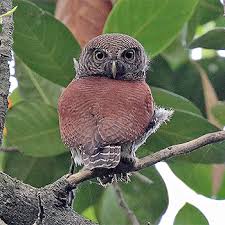World Famous Endemic Birds
Saturday, February 27, 2016
Monday, December 28, 2015
The Chestnut-Backed Owlet
The Chestnut-Backed Owlet(Glaucidium castanonotum )
Lanka Pitathabala Vana-Bassa

About the size of the Collared Scops Owl. Sexes alike. This little owl is very like the last species in shape, size, and general apperance but it is chestnut on back, scapulars, and wing-coverts, and has white underparts marked with blackish shaft-streaks, and bars on the flanks. Some specimens have white spots on the outer scapulars. Irides bright yellow; feet pale yellow.It is shy and wary, and as it frequents the tops of tall trees, usually on steep hillsides, it is seldom seen. It is very diurnal in habits, often hunting and calling in broad daylight. The Mukalan Bassa feeds mainly on insects, such as beetles, but also captures mice, small lizards, and small birds, on occasion; most likely, the larger vertebrate forms of prey are taken only when young are being fed.The breeding season is from March to May, the eggs being laid on the bare wood in a hole in the trunk or limb of a tree. The two glossy white eggs measure about 35 × 28.2 mm.
This owl appears to have been fairly common in Legge's time in many parts of the southern half of the Island, especially the hills and wet-zone low country extending to outskirts of Colombo; but its range has undoubtedly shrunk very greatly since then, and it is now found sparingly in the remaining forests of the wet zone and adjoining hills up to 6,500 feet.


Size
Length of body = 8.25 inches(20cm)
Length of wing = 4.2 -4.4 inches
Length of tail = 3.1-3.5 inches
Length of beak= 1.25 inches
Distribution and habitat
The chestnut-backed owlet is a common resident bird in the wet zone forests of Sri Lanka, and can be seen easily at sites such as Kitulgala and Sinharaja. Historical reports of its distribution by Legge include many parts of the southern half of Sri Lanka, especially the hills and the wet-zone low country extending to the outskirts of Colombo. In recent times, its range has shrunk greatly, and it is now found sparingly in the remaining forests of the wet zone and the adjoining hills up to 6500 ft above sea leve.
 v
v 
Lanka Pitathabala Vana-Bassa
About the size of the Collared Scops Owl. Sexes alike. This little owl is very like the last species in shape, size, and general apperance but it is chestnut on back, scapulars, and wing-coverts, and has white underparts marked with blackish shaft-streaks, and bars on the flanks. Some specimens have white spots on the outer scapulars. Irides bright yellow; feet pale yellow.It is shy and wary, and as it frequents the tops of tall trees, usually on steep hillsides, it is seldom seen. It is very diurnal in habits, often hunting and calling in broad daylight. The Mukalan Bassa feeds mainly on insects, such as beetles, but also captures mice, small lizards, and small birds, on occasion; most likely, the larger vertebrate forms of prey are taken only when young are being fed.The breeding season is from March to May, the eggs being laid on the bare wood in a hole in the trunk or limb of a tree. The two glossy white eggs measure about 35 × 28.2 mm.
This owl appears to have been fairly common in Legge's time in many parts of the southern half of the Island, especially the hills and wet-zone low country extending to outskirts of Colombo; but its range has undoubtedly shrunk very greatly since then, and it is now found sparingly in the remaining forests of the wet zone and adjoining hills up to 6,500 feet.
Size
Length of body = 8.25 inches(20cm)
Length of wing = 4.2 -4.4 inches
Length of tail = 3.1-3.5 inches
Length of beak= 1.25 inches
Distribution and habitat
The chestnut-backed owlet is a common resident bird in the wet zone forests of Sri Lanka, and can be seen easily at sites such as Kitulgala and Sinharaja. Historical reports of its distribution by Legge include many parts of the southern half of Sri Lanka, especially the hills and the wet-zone low country extending to the outskirts of Colombo. In recent times, its range has shrunk greatly, and it is now found sparingly in the remaining forests of the wet zone and the adjoining hills up to 6500 ft above sea leve.
Subscribe to:
Posts (Atom)